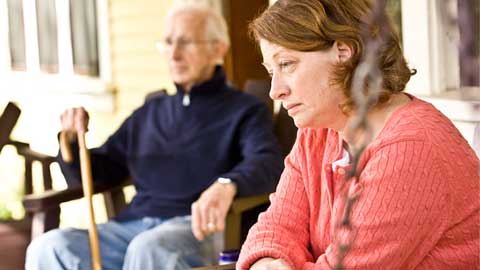
Izzy Gore
Senior care in the United States today is a broken industry. With Alzheimer’s as the 6th-leading cause of death, care for those dealing with this and other conditions is constantly in demand. The costs associated with professional senior care can be untenable for many families who would wish to utilize it. Full-time care in a private nursing home in Washington costs an average of $7,890 per month (NPR). Prohibitive price tags leave family members to care for seniors alone. These caregivers provide billions of hours of unpaid labor annually. If family members cannot care for seniors themselves, they often must cut back on their own costs of living in order to pay for the care of their elders. Though the costs of such care are high, even professional caregivers working in nursing homes and assisted living centers are underpaid; most make minimum wage or little more.
Many of these issues stem from a cultural undervaluing of senior citizens and the coding of caregiving and nursing as traditionally feminine forms of labor (not considered to be economically viable in a capitalist system). Alternatives exist: some senior caregivers are working to unionize for better pay and working conditions, while others are exploring the possibility of cooperative senior care facilities or examining the option of compensation for family caregivers.
Problems in the System

Senior care today does not often serve the needs of the seniors to which it caters. The elderly population in the United States is on the rise. By 2030 the number of people aged 65 or older will be larger than the number of people younger than 18 for the first time in U.S. history (U.S. Census). As the Baby Boomers age, the elderly population will balloon—along with the need for elder care. This growing demographic has exacerbated problems present in the current system of elder care which must be addressed before current systems can be expanded to include new beneficiaries. As mentioned above, senior care facilities can be prohibitively expensive to many who would wish to live in them. In-home care giving professionals can carry an even larger price tag, and frequently these services are limited by lack of staff or incompatibility with insurance. If seniors or their families are able to afford institutional care, it often falls short of their needs; such facilities can often be so homogeneous that they ignore the specific needs and differences among residents.
For example, there is a gap in care specifically for LGBT seniors, and even more specifically for LGBT seniors of color. Due to systemic injustices, these seniors are often at higher risk for health problems and financial disadvantage; as a result, they are often ignored by the senior care industry and their needs are not met (Adams). These gaps in care can cause social isolation that will further negatively affect the health of these seniors and can, in fact, cause them to require full-time care sooner than they otherwise would have.
Caregivers: Professional and Informal
Professional caregivers in senior care facilities or in people’s homes are often the image brought to mind when discussing senior caregivers. While these workers are exploited and underrepresented, they do not make up the majority of caregivers in the United States. For the most part, caregivers are unpaid family members and community members. There are about 65 million people in the United States identified as caregivers for at least one elderly, disabled, or chronically ill family member (U.S. Census). Those identified care for their relatives for an average of 20 hours per week, and the value of the services that they provide is estimated at approximately $375 billion per year—which the Caregiver Action Network notes is nearly twice the amount of money spent annually on paid professional caregivers (Chari).
Devaluation and Feminization of Reproductive Labor
Unpaid, informal caregivers make up an enormous section of the U.S. economy and senior care system, yet their labor is often unacknowledged and unseen. In order to determine why, it is necessary to acknowledge the gender divisions that exist in care giving; most informal senior caregivers are women. Deanna Chitayat writes for the American Psychological Association that “Gender norms across the world expect women to bear the burden of caring for the ill. Many men believe that caring is ‘women’s work’ and that it is beneath them, that their role as breadwinners should exclude them from domestic chores” (Chitayat). While they note this as an explicit bias (one which men are aware of and even consciously perpetuate) its effects are often implicit and unexamined. Stay-at-home mothers are coded as lazy and unproductive whereas stay-at-home fathers are often praised for being engaged in their children’s lives. Women are often painted as sympathetic and nurturing.
Overworked and Underpaid
While these are stereotypes in themselves, the quantifiable effects of such perceptions must also be realized. Caregiving work is largely feminized and is also some of the least compensated work in the modern U.S. capitalist economy (Chitayat). Childcare, for example, is not something for which parents are compensated; often they cannot even receive paid leave when a child is born. Cooking for a family, cleaning a home, and doing laundry are perceived as necessary chores that deserve no compensation. This ‘reproductive’ labor (so called because it allows the labor force to ‘reproduce’ itself both daily and generationally) is considered non-productive in a capitalist system, and those
who perform it are inevitably exploited. Elder care falls into this category; family members are the most likely caregivers for aging parents and relatives but their labor is labeled non-productive and goes uncompensated.

Besides labor exploitation, there are other consequences for informal care giving; according to a study conducted by researchers at Rice University, “Women who are family caregivers are 2.5 times more likely than non-caregivers to live in poverty and five times more likely to receive Supplemental Security Income” (U.S. Census). A study by the University of California found that the level of stress experienced by family caregivers could decrease their life spans by up to ten years. This system has consequences for a capitalist economy as well; a study by MetLife found that U.S. businesses lose approximately $34 billion annually due to employees who need to care for senior family members (U.S. Census).
Paid caregivers are also victims of the devaluation of reproductive labor; in an industry that charges exorbitant prices they are often paid minimum wage or little more—often with no benefits whatsoever. Caregiving is an arduous task that exacts a great emotional and physical toll even on those who are paid for it; many of the same stressors that affect informal caregivers are present in professional positions as well.
Gaps in Care
One of the largest issues facing the industry of senior care is a lack of staffing. An article by Alana Semuels for The Atlantic points out that, “In 2010, one-sixth of the adult U.S. population was older than 65; by 2030, about one-fourth will be” (Semuels). Semuels outlines the way gaps in care giving staff have negatively affected America’s senior population; many seniors do not have access to in-home care because their local agencies are short-staffed. Seniors often prefer in-home caregivers because of the relative independence and emotional security that living at home provides, but certified in-home caregivers often cannot be found. Insurance plans will sometimes only cover one local agency which may not have any available aides. Agencies can also have requirements that seniors do not meet; for example, one woman in the aforementioned article simply needed a home health aide to help get her husband in and out of bed each day, but the local agency required a two-hour minimum visit (Semuels).

With a lack of professional caregivers already causing problems for seniors who need them, the rapidly increasing percentage of senior citizens in the country becomes very concerning. Shortages of professional caregivers will only continue to get worse as the population ages. It is estimated that the demand for senior caregivers will grow 37% from 2012 to 2022 (Semuels). With home health care becoming a rapidly growing industry, and Certified Nursing Assistant certification programs taking only about six weeks to complete, the obvious question is why people have not flocked to available jobs. To provide some context, Semuels notes,
“On average, home care aides work 34 hours a week, and make an average of $17,000 a year. One in four live in households below the federal poverty line, and one in three doesn’t have health care because their employer doesn’t offer it or because they can’t afford it. Perhaps unsurprisingly, the field has a high rate of turnover—some estimates put it as high as 60 percent.”
Semuels quotes Deane Beebe, a spokeswoman for the Paraprofessional Healthcare Institute: “These are very hard jobs. They’re very physically taxing—they have one of the highest injury rates of any occupation—and they’re very emotionally taxing: It’s intimate work; it’s isolating work” (Semuels). For many caregivers, this rings true. Caring for another human being is difficult work, and as Semuels points out the benefits are few and far between. The resulting gaps in care have driven some seniors and their families to seek help from outside the system; many will post ads seeking help from untrained, unofficial caregivers. People who have no experience in healthcare or caregiving will often work with families who have no other choice. These unofficial caregivers serve a vital purpose to the families they help, and many may do an excellent job, but there is no way to ensure that they are doing more good than harm and are behaving professionally with clients (Semuels).
Some, completely failed by the in-home health care system, are forced to go into assisted living facilities earlier than they otherwise would have. This change can often cause increased stress and can have detrimental effects on the health of the seniors. Such facilities can often be underfunded and understaffed as well, creating an environment that prioritizes efficiency and homogeneity over patient-centered care.
Solutions and Alternatives
The system is very clearly broken. Seniors are unable to get the quality of care that they deserve and need to live happy, healthy lives. Caregivers, both paid and unpaid, are being exploited by a system that devalues the vital work that they do. With the senior citizen population rapidly increasing over the next two decades it is vital that the system of senior care in the United States be changed to better suit the needs of everyone involved. Without intervention, the state of senior care will deteriorate rapidly in the coming years.
There is a surprising lack of coverage of proposed solutions to senior care issues. Guides exist for residents and their families to negotiate better care from assisted living facilities, and there are many articles describing the issues facing both seniors and caregivers in the United States today, but there is little written about possible alternatives to this system of care. Despite widespread acknowledgment that the current situation is dire, the conversation about solutions often seems to boil down to a Thatcheresque nursing home spokesperson insisting that “There is no alternative.” However, new solutions do exist.
Caregiver Unions

The least radical reform proposed has been the formation of caregiver unions. There have been several attempts to unionize in-home caregivers in order to ensure fair pay and good working conditions, but several laws have made widespread implementation difficult. For example, Illinois rules that such unions could not require members to pay union dues (Simon). This law was opposed by many who believe that it will hurt union efforts by reducing the funds that unions are able to raise to fight for their causes. Furthermore, this solution does not address many of the issues still facing the industry. Unionizing caregivers is an important goal, but it would not address the overall structural problems of senior care. It would do nothing to improve the lives of family caregivers or make professional care more affordable for those who wish to seek it. While unionizing is an important step, a more extreme change is needed.
Cooperatives
One such alternative was proposed in a case study by the University of Georgia, which examined the wages and lifestyles of parents who became worker-owners in a childcare cooperative. Participants in the care cooperative saw their hourly wages increase roughly 58% after becoming members (Science Daily). They also reported that increased wages allowed them to cut back on their working hours, which in turn gave them opportunities to spend more time with their children. The researchers

from the University of Georgia suggested that a similar system could be applied to senior care; currently senior homes are either privately funded or given public assistance, but so far, no senior homes have attempted to employ a cooperative model. Such a model would allow participating workers to become part owners, meaning that they would see a part of any profits made from running the center. The cooperative system, as it has in similar instances, would incentivize workers to increase the quality of care for those who live in the facility. Each worker-owner would have a vested interest in seeing seniors receive the best care, and would also have a say in their own working conditions. This system has the potential to increase the quality of life for both seniors and workers.
Payment for Family Caregivers
Alternatively, there is the option of paying informal caregivers for their labor. As it stands, caring for loved one can a full time job. Caregivers suffer steep physical and emotional consequences, not to mention the clear financial burdens of lost wages due to time spent caring for parents and relatives. Being a caregiver is a difficult and taxing job even when it is paid, and doing this work for free should be unheard of (see Women’s Labor Under Capitalism). Compensating reproductive labor is an unpopular—almost heretical—idea in capitalist society, but it is necessary if the seniors of today and tomorrow are going to receive adequate care. Some programs to pay family caregivers do exist; for example, legislation allows post-9/11 war veterans a cash allowance to pay whoever they see fit for providing care. A survey found that 35 states (including Washington D.C. and Puerto Rico) have programs that allow for some kind of payment to be made to family members who are caring for a relative with a disability (Simon-Rusinowitz).
Conclusion
Caregiver compesation programs do exist, but they are not widespread and certainly not universal. Barriers to such programs come in the form of economic objections to the practicality of such spending, as well as moral issues raised by those who believe that caring for elders is a familial obligation for which compensation is not appropriate. However, the potential benefits outweigh the objections. As described above, informal family caregivers suffer severe financial, emotional, and physical consequences for the work they do. This enormous section of the population is subject to increased stress, financial hardship, and poor health. Providing a universal basic income to these caregivers would provide a better standard of living for both the caregivers and the people for whom they are responsible.
There are alternatives to the current system, but they remain largely underdeveloped. News outlets are quick to write articles that criticize the current system and slow to provide alternatives. The state of senior care in the United States is miserable; it serves very few people as effectively as it should. The critiques are valid and necessary. But there is an alternative, several in fact. In order to protect both the seniors we love and those who care for them, the alternatives must be acknowledged and explored.
Sources
Abel, E. K. (1991). Who cares for the elderly?: public policy and the experiences of adult daughters. Philadelhpia: Temple University Press.
Adams, M. m. (2016). An Intersectional Approach to Services and Care for LGBT Elders. Generations.
Beedholm, K., Frederiksen, K., Frederiksen, A. S., & Lomborg, K. (2015). Attitudes to a robot bathtub in Danish elder care: A hermeneutic interview study. Nursing & Health Sciences.
Carlson, E. (2015, July). 20 Common Nursing Home Problems. Justice in Aging.
Carroll, A. E. (2017, February 6). How Would Republican Plans for Medicaid Block Grants Actually Work? New York Times.
Chari, A. V., Engberg, J., Ray, K. N., & Mehrotra, A. (2015). The opportunity costs of informal elder-care in the United States: New estimates from the American time use survey. Health Services Research.
Chitayat, D., PhD. (2009, July). Gender Equality in Caregiving: The United Nations Response. American Psychological Association.
Dahl, H. M., Eskelinen, L., & Hansen, E. B. (2015). Coexisting principles and logics of elder care: Help to self-help and consumer-oriented service?. International Journal Of Social Welfare.
Ducharme, J. (2017, January 22). Gov. Baker Slashed Funding for Opioid, HIV, and Elder Care Programs. Boston Magazine.
Flores, Y., Hinton, L., Barker, J., Franz, C., & Velasquez, A. (2010, December 30). Beyond Familism: Ethics of Care of Latina Caregivers of Elderly Parents With Dementia. NCBI.
NPR. (2012, April 27). The Cost Of Elder Care. NPR
Ramnarace, C. (2012, July 02). Care gap looms large for aging baby boomers. Reuters.
Science Daily. (2017, January 5). Worker-owned cooperatives may help address elder care deficit. Science Daily.
Semuels, A. (2015, April 27). Who will care for America’s seniors? The Atlantic.
Simon, S. (2014, June 30). For unions, not a fatal verdict. Politico.
Simon-Rusinowitz, L., Mahones, K. J., & Benjamin, A. (1998). Payments to Families Who Provide Care: An Option That Should Be Available. Generations.
Skira, M. M. (2015). Dynamic wage and employment effects of elder parent care. International Economic Review.
US Census Bureau. (2016, April 15). FFF: Older Americans Month: May 2016. US Census.
Varney, S. (2015, May 26). More seniors are going hungry. CNN.